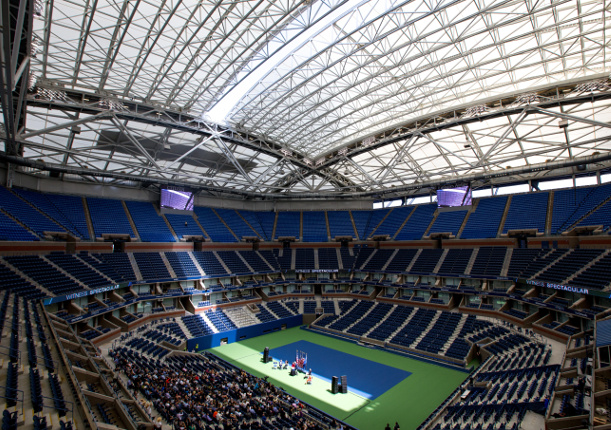By Richard Pagliaro | Thursday, August 18, 2016
Shifting sightlines, robotic cameras in the interview room and camera coverage on 12 courts highlight ESPN's 2016 US Open coverage.
Photo credit: ESPN
The 2016 US Open is a coming-out party for the new retractable roof over Arthur Ashe Stadium—and a surprise party for host broadcaster ESPN.
ESPN executives aren't exactly sure how the $150 million roof will impact the sights and sounds of their coverage because they can't test the environment with the 23,771-seat Ashe Stadium filled to capacity.
More: US Open Roof Raising Provides Spectacle and Suspense
"We have cameras being built this week as well as next week and audio technicians are down there assessing what the house looks and feels like, what it sounds like under all conditions during the day or at night with total darkness," ESPN vice president of production Jamie Reynolds said in a conference call with the media today to promote the network's US Open coverage. "Once you fill it with 20,000 to 25,000 people, it will certainly shape the temperature range, what the wind currents might be. I think we're all looking forward to what that house can project or optimize for us and how the nuances may affect the game or enhance the game.
"I think everyone, including the USTA, National Tennis Center, broadcasters alike, are looking forward to seeing how the event presents itself... It's going to be interesting. I think we're all waiting in baited anticipation."
The US Open begins on August 29th.
ESPN will provide camera coverage on a total of 12 courts and maintain its studio set on the practice courts.
Sightlines will shift on Ashe Stadium as shadows cast from the roof will intersect the court.
"I think the shadowing will now be a new ingredient. Even though it's a wide opening, you're now going to have angular lines criss-crossing the court now," Reynolds said. "It's going to look a little bit more like Australia than the rounded edges and sight lines we've historically seen there. So it's going to look and feel different at different times of the day.
"The wind swirl, I think it's going to be neutralized because you don't have the bowl effect that you had with the open top so that will change for the players as well as the fan base what it actually feels like."

A year ago, the first all-ESPN US Open in history delivered an average audience of 1,265,000 viewers on ESPN and ESPN2, which was a 20 percent rise from the to 1,054,000 audience of 2014.
The most-viewed US Open since 2011 brought some breakthrough moments—Pam Shriver conducted the first-ever mid-match interview at a Grand Slam with CoCo Vandeweghe—and disappointment. No first-week live TV coverage of the 11 a.m. to 1 p.m. matches the start the day, which Tennis Channel televised in prior years, was a step back in the first year of ESPN's exclusive 11-year US Open television pact with the USTA.
So will we see another mid-match interview in New York this month?
Probably not.
Reynolds told Tennis Now major stakeholders seek a consensus for uniformity at the Grand Slams.
"I think we all learned a lot through that exercise. It was a wake-up call for all of us: Broadcasters, media as well as the four majors, ATP, WTA and ITF," Reynolds said. "This gang of seven that are the folks that steer the future of the sport come together and start to figure out what can we do to offer more value to our fan base.
"It all comes to a consensus that this is good for sport. But we have to be aligned with how we do it at all of the events. So there's been a lot of conversations behind-the-scenes among all of those rights holders trying to get our respective compasses orientated in the right direction and those meetings will continue to take shape as they have at the other majors.
"We're going to continue to push the envelope. To your specific question: Are there plans to do it right now? I don't know if I can commit to that answer."
While you likely won't see players conduct interviews during matches, ESPN3 viewers will be able to watch player post-match press conferences in the main interview room throughout the tournament.

"We realized the value as a 24-hour network we thrive on live content," Reynolds said. "And what we've learned at a variety of other events is the more we can take advantage of a second-screen opportunity, the more valuable it is for the rights holder and the more valuable it is to serve the fan at that moment."
Robotic cameras installed in the main press room will capture the question and answer rally between players and journalists bringing viewers inside the media room.
"So we went to the USTA a year ago with the concept of rather than just having a single camera coverage of the press room and letting broadcasters record sound or go to that feed live when appropriate, what if we create a multi-camera switch feed that is now a live signal that starts at 11 am and runs thru last presser of each day," Reynolds said. "And in that interactivity our goal is to enhance the exchange between the press corps as well as whoever is in the press room at the time.
"So in the multi-camera coverage we will have robotic cameras trained both on the press corps as well as the principal speaking. Our goal in that interactivity is to try to capture that dynamic of what folks find interesting: To hear that first-hand account of questions and answers and hear that dialogue and offer that as a continuous service.
"If you want to click that on E-3 channel and watch it on your desk top and wait for all the pressers to come through all day long you're welcome to do it and on another screen watch the match coverage."